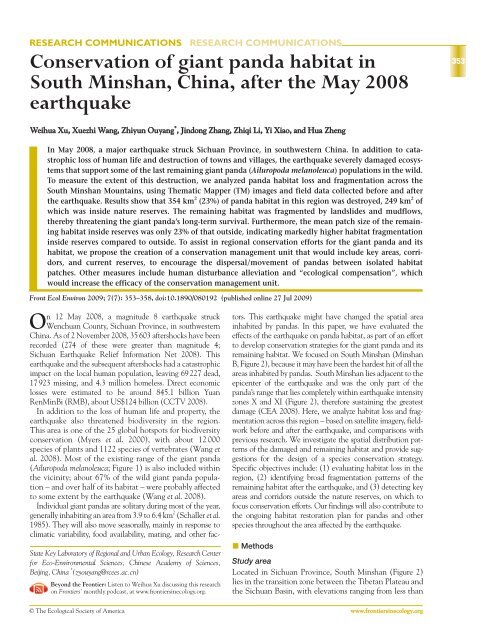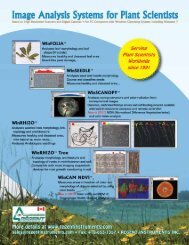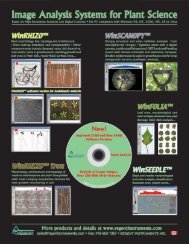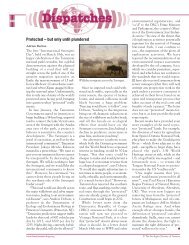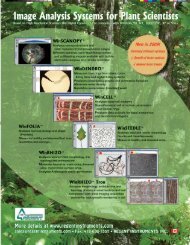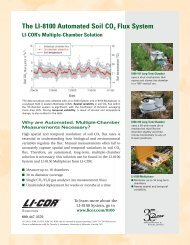Conservation of giant panda habitat in South Minshan, China, after ...
Conservation of giant panda habitat in South Minshan, China, after ...
Conservation of giant panda habitat in South Minshan, China, after ...
You also want an ePaper? Increase the reach of your titles
YUMPU automatically turns print PDFs into web optimized ePapers that Google loves.
RESEARCH COMMUNICATIONS RESEARCH COMMUNICATIONS<strong>Conservation</strong> <strong>of</strong> <strong>giant</strong> <strong>panda</strong> <strong>habitat</strong> <strong>in</strong><strong>South</strong> M<strong>in</strong>shan, Ch<strong>in</strong>a, <strong>after</strong> the May 2008earthquake353Weihua Xu, Xuezhi Wang, Zhiyun Ouyang * , J<strong>in</strong>dong Zhang, Zhiqi Li, Yi Xiao, and Hua ZhengIn May 2008, a major earthquake struck Sichuan Prov<strong>in</strong>ce, <strong>in</strong> southwestern Ch<strong>in</strong>a. In addition to catastrophicloss <strong>of</strong> human life and destruction <strong>of</strong> towns and villages, the earthquake severely damaged ecosystemsthat support some <strong>of</strong> the last rema<strong>in</strong><strong>in</strong>g <strong>giant</strong> <strong>panda</strong> (Ailuropoda melanoleuca) populations <strong>in</strong> the wild.To measure the extent <strong>of</strong> this destruction, we analyzed <strong>panda</strong> <strong>habitat</strong> loss and fragmentation across the<strong>South</strong> M<strong>in</strong>shan Mounta<strong>in</strong>s, us<strong>in</strong>g Thematic Mapper (TM) images and field data collected before and <strong>after</strong>the earthquake. Results show that 354 km 2 (23%) <strong>of</strong> <strong>panda</strong> <strong>habitat</strong> <strong>in</strong> this region was destroyed, 249 km 2 <strong>of</strong>which was <strong>in</strong>side nature reserves. The rema<strong>in</strong><strong>in</strong>g <strong>habitat</strong> was fragmented by landslides and mudflows,thereby threaten<strong>in</strong>g the <strong>giant</strong> <strong>panda</strong>’s long-term survival. Furthermore, the mean patch size <strong>of</strong> the rema<strong>in</strong><strong>in</strong>g<strong>habitat</strong> <strong>in</strong>side reserves was only 23% <strong>of</strong> that outside, <strong>in</strong>dicat<strong>in</strong>g markedly higher <strong>habitat</strong> fragmentation<strong>in</strong>side reserves compared to outside. To assist <strong>in</strong> regional conservation efforts for the <strong>giant</strong> <strong>panda</strong> and its<strong>habitat</strong>, we propose the creation <strong>of</strong> a conservation management unit that would <strong>in</strong>clude key areas, corridors,and current reserves, to encourage the dispersal/movement <strong>of</strong> <strong>panda</strong>s between isolated <strong>habitat</strong>patches. Other measures <strong>in</strong>clude human disturbance alleviation and “ecological compensation”, whichwould <strong>in</strong>crease the efficacy <strong>of</strong> the conservation management unit.Front Ecol Environ 2009; 7(7): 353–358, doi:10.1890/080192 (published onl<strong>in</strong>e 27 Jul 2009)State Key Laboratory <strong>of</strong> Regional and Urban Ecology, Research Centerfor Eco-Environmental Sciences, Ch<strong>in</strong>ese Academy <strong>of</strong> Sciences,Beij<strong>in</strong>g, Ch<strong>in</strong>a * (zyouyang@rcees.ac.cn)Beyond the Frontier: Listen to Weihua Xu discuss<strong>in</strong>g this researchon Frontiers’ monthly podcast, at www.frontiers<strong>in</strong>ecology.org.On 12 May 2008, a magnitude 8 earthquake struckWenchuan County, Sichuan Prov<strong>in</strong>ce, <strong>in</strong> southwesternCh<strong>in</strong>a. As <strong>of</strong> 2 November 2008, 35 603 <strong>after</strong>shocks have beenrecorded (274 <strong>of</strong> these were greater than magnitude 4;Sichuan Earthquake Relief Information Net 2008). Thisearthquake and the subsequent <strong>after</strong>shocks had a catastrophicimpact on the local human population, leav<strong>in</strong>g 69 227 dead,17 923 miss<strong>in</strong>g, and 4.3 million homeless. Direct economiclosses were estimated to be around 845.1 billion YuanRenM<strong>in</strong>Bi (RMB), about US$124 billion (CCTV 2008).In addition to the loss <strong>of</strong> human life and property, theearthquake also threatened biodiversity <strong>in</strong> the region.This area is one <strong>of</strong> the 25 global hotspots for biodiversityconservation (Myers et al. 2000), with about 12 000species <strong>of</strong> plants and 1122 species <strong>of</strong> vertebrates (Wang etal. 2008). Most <strong>of</strong> the exist<strong>in</strong>g range <strong>of</strong> the <strong>giant</strong> <strong>panda</strong>(Ailuropoda melanoleuca; Figure 1) is also <strong>in</strong>cluded with<strong>in</strong>the vic<strong>in</strong>ity; about 67% <strong>of</strong> the wild <strong>giant</strong> <strong>panda</strong> population– and over half <strong>of</strong> its <strong>habitat</strong> – were probably affectedto some extent by the earthquake (Wang et al. 2008).Individual <strong>giant</strong> <strong>panda</strong>s are solitary dur<strong>in</strong>g most <strong>of</strong> the year,generally <strong>in</strong>habit<strong>in</strong>g an area from 3.9 to 6.4 km 2 (Schaller et al.1985). They will also move seasonally, ma<strong>in</strong>ly <strong>in</strong> response toclimatic variability, food availability, mat<strong>in</strong>g, and other factors.This earthquake might have changed the spatial area<strong>in</strong>habited by <strong>panda</strong>s. In this paper, we have evaluated theeffects <strong>of</strong> the earthquake on <strong>panda</strong> <strong>habitat</strong>, as part <strong>of</strong> an effortto develop conservation strategies for the <strong>giant</strong> <strong>panda</strong> and itsrema<strong>in</strong><strong>in</strong>g <strong>habitat</strong>. We focused on <strong>South</strong> M<strong>in</strong>shan (M<strong>in</strong>shanB, Figure 2), because it may have been the hardest hit <strong>of</strong> all theareas <strong>in</strong>habited by <strong>panda</strong>s. <strong>South</strong> M<strong>in</strong>shan lies adjacent to theepicenter <strong>of</strong> the earthquake and was the only part <strong>of</strong> the<strong>panda</strong>’s range that lies completely with<strong>in</strong> earthquake <strong>in</strong>tensityzones X and XI (Figure 2), therefore susta<strong>in</strong><strong>in</strong>g the greatestdamage (CEA 2008). Here, we analyze <strong>habitat</strong> loss and fragmentationacross this region – based on satellite imagery, fieldworkbefore and <strong>after</strong> the earthquake, and comparisons withprevious research. We <strong>in</strong>vestigate the spatial distribution patterns<strong>of</strong> the damaged and rema<strong>in</strong><strong>in</strong>g <strong>habitat</strong> and provide suggestionsfor the design <strong>of</strong> a species conservation strategy.Specific objectives <strong>in</strong>clude: (1) evaluat<strong>in</strong>g <strong>habitat</strong> loss <strong>in</strong> theregion, (2) identify<strong>in</strong>g broad fragmentation patterns <strong>of</strong> therema<strong>in</strong><strong>in</strong>g <strong>habitat</strong> <strong>after</strong> the earthquake, and (3) detect<strong>in</strong>g keyareas and corridors outside the nature reserves, on which t<strong>of</strong>ocus conservation efforts. Our f<strong>in</strong>d<strong>in</strong>gs will also contribute tothe ongo<strong>in</strong>g <strong>habitat</strong> restoration plan for <strong>panda</strong>s and otherspecies throughout the area affected by the earthquake. MethodsStudy areaLocated <strong>in</strong> Sichuan Prov<strong>in</strong>ce, <strong>South</strong> M<strong>in</strong>shan (Figure 2)lies <strong>in</strong> the transition zone between the Tibetan Plateau andthe Sichuan Bas<strong>in</strong>, with elevations rang<strong>in</strong>g from less than© The Ecological Society <strong>of</strong> America www.frontiers<strong>in</strong>ecology.org
Panda <strong>habitat</strong> conservationXu et al.354Ch<strong>in</strong>a <strong>Conservation</strong> and Research Center for the Giant PandaFigure 1. Giant <strong>panda</strong> (Ailuropoda melanoleuca), observed <strong>after</strong> the May 12earthquake.100 m to more than 4000 m. Five counties (Dujiangyan,Pengzhou, Shifang, Mianzhu, and Anxian) were <strong>in</strong>cluded<strong>in</strong> the 6093-km 2 study area. The area conta<strong>in</strong>s four naturereserves, established between 1993 and 1999, for the conservation<strong>of</strong> <strong>giant</strong> <strong>panda</strong>s, as well as diverse natural ecosystemsand other endangered species (eg golden monkey[Rh<strong>in</strong>opithecus roxellana] and tak<strong>in</strong> [Budorcas taxicolor]).Two <strong>of</strong> these reserves are national nature reserves (Longxihongkouand Baishuihe) and two are prov<strong>in</strong>cial (state)nature reserves (Jiud<strong>in</strong>gshan and Qianfoshan).Land-cover classificationTo map <strong>habitat</strong> loss caused by the earthquake and its <strong>after</strong>math(eg landslides and mudflows), we used threeThematic Mapper (TM) images acquired on 19 May 2006,18 September 2007, and 8 July 2008. The first two imageswere provided by the US Geological Survey, and the thirdwas provided by the Ch<strong>in</strong>a Remote Sens<strong>in</strong>g SatelliteGround Station. Although the 2007 image served as theprimary data source for the pre-earthquake stage, cloudsobscured approximately 5% <strong>of</strong> this image – therefore, weused the correspond<strong>in</strong>g cloud-free areas with<strong>in</strong> the 2006image to complement the cloud-covered sections <strong>of</strong> the2007 image. The three images were georeferenced to theWGS 84 coord<strong>in</strong>ate system, with a pixel size <strong>of</strong> 30 m x 30m. A supervised classification was carried out <strong>in</strong> ERDAS9.1 for the three images. Because forests are the ma<strong>in</strong> vegetationtypes used by <strong>giant</strong> <strong>panda</strong>s (Liu et al. 2001), and previouslyundisturbed forest <strong>habitat</strong> was essentially convertedto “bare land” by the earthquake and subsequentlandslides and mudflows, areas with<strong>in</strong> the pre-earthquakeimages were classified as forest, bare land, or “other”, andthat with<strong>in</strong> the post-earthquake image as bare land or“other”. This classification system allowed for pre-earthquake<strong>habitat</strong> evaluation and post-earthquake <strong>habitat</strong>change detection. Sample po<strong>in</strong>ts collected <strong>in</strong> the fieldwere used for image classification and to assess accuracy.For the pre-earthquake images, 60 <strong>of</strong> the 100 sample po<strong>in</strong>tscollected by researchers between 2005 and2007 were randomly selected for the tra<strong>in</strong><strong>in</strong>gset, and the rema<strong>in</strong><strong>in</strong>g 40 for accuracy assessment.For the post-earthquake image, weused 96 sample po<strong>in</strong>ts collected betweenJune and October 2008, with 60 for thetra<strong>in</strong><strong>in</strong>g set and 36 for accuracy assessment.The total classification accuracy was 87%and 91%, respectively, for the pre- and postearthquakestages. We overlaid the classificationfrom before and <strong>after</strong> the earthquake,which revealed the distribution <strong>of</strong> new bareland created as a result <strong>of</strong> the earthquake andits subsequent impacts.Changes <strong>in</strong> <strong>giant</strong> <strong>panda</strong> <strong>habitat</strong>Possible <strong>giant</strong> <strong>panda</strong> <strong>habitat</strong> <strong>in</strong> the pre-earthquakeimage was evaluated accord<strong>in</strong>g to a conceptual model(Liu et al. 2001; Xu et al. 2006) and known biologicalrequirements <strong>of</strong> <strong>giant</strong> <strong>panda</strong>s (State Forestry Adm<strong>in</strong>istration2006). Suitable <strong>habitat</strong> for the <strong>giant</strong> <strong>panda</strong> is considered tobe a function <strong>of</strong> four ma<strong>in</strong> criteria: (1) presence <strong>of</strong> forestcover; (2) presence <strong>of</strong> bamboo; (3) elevations between 1000and 3800 m; and (4) slopes <strong>of</strong> less than 50˚. For the preearthquakeassessment, we comb<strong>in</strong>ed forest-cover dataobta<strong>in</strong>ed from the image classification with slope, elevation,and bamboo presence data. The slope and elevation datawere obta<strong>in</strong>ed from digital elevation model data (1:50 000)acquired from The National Geomatics Center <strong>of</strong> Ch<strong>in</strong>a,and bamboo distribution data were obta<strong>in</strong>ed from the ThirdNational Panda Survey (State Forestry Adm<strong>in</strong>istration2006). The result<strong>in</strong>g <strong>habitat</strong> map <strong>of</strong> pre-earthquake conditionswas overlayed with the bare land distribution result<strong>in</strong>gfrom the earthquake, reveal<strong>in</strong>g the extent <strong>of</strong> the lost <strong>habitat</strong>.The total area <strong>of</strong> lost and rema<strong>in</strong><strong>in</strong>g <strong>habitat</strong> was comparedacross different elevations and slopes, between variouscounties and reserves, and <strong>in</strong>side and outside <strong>of</strong> <strong>in</strong>dividualreserves. We also compared <strong>habitat</strong> fragmentationacross these areas before and <strong>after</strong> the earthquake, us<strong>in</strong>glandscape <strong>in</strong>dices <strong>of</strong> the number <strong>of</strong> patches (NP) andmean patch size (MPS) calculated via Fragstats 3.3(McGarigal et al. 2002). A decrease <strong>in</strong> MPS can <strong>in</strong>dicatean <strong>in</strong>crease <strong>in</strong> fragmentation <strong>of</strong> a <strong>habitat</strong>.Designation <strong>of</strong> key areas and corridors <strong>in</strong> therema<strong>in</strong><strong>in</strong>g <strong>habitat</strong> outside nature reservesGiven the large proportion <strong>of</strong> <strong>habitat</strong> lost and fragmented<strong>in</strong>side the nature reserves, it was important to identify potentialkey <strong>habitat</strong> outside the nature reserves, so that these couldbecome the focus <strong>of</strong> conservation efforts, and for the potentialestablishment <strong>of</strong> future nature reserves. The criteria we usedto select key areas were that they (1) conta<strong>in</strong>ed large areas <strong>of</strong>suitable <strong>habitat</strong>, where <strong>panda</strong>s were distributed, (2) wereadjacent to current nature reserves, and (3) had relatively lowlevels <strong>of</strong> human disturbance. Corridors were also needed towww.frontiers<strong>in</strong>ecology.org© The Ecological Society <strong>of</strong> America
Xu et al.Panda <strong>habitat</strong> conservation355EpicenterPanda distributionEarthquake <strong>in</strong>tensityXXIElevation (m)High: 7206Figure 2. <strong>South</strong> M<strong>in</strong>shan (boundary depicted by the red l<strong>in</strong>e). The <strong>panda</strong> distribution area <strong>in</strong> <strong>South</strong> M<strong>in</strong>shan (“M<strong>in</strong>shan B”) is almostcompletely with<strong>in</strong> the earthquake <strong>in</strong>tensity regions X and XI, the areas most seriously damaged <strong>in</strong> the May 2008 Wenchuan earthquake.allow <strong>panda</strong>s to move between isolated <strong>habitat</strong> patches. Thecriteria for proposed corridors were that they (1) were with<strong>in</strong>a short distance (less than 2 km) <strong>of</strong> key areas, (2) conta<strong>in</strong>edsuitable <strong>habitat</strong>, and (3) experienced a low amount <strong>of</strong> humandisturbance (Xu et al. 2006). ResultsCharacteristics <strong>of</strong> lost <strong>panda</strong> <strong>habitat</strong>Panda <strong>habitat</strong> <strong>in</strong> the study area decreased from 1536 to1182 km 2 , <strong>in</strong>dicat<strong>in</strong>g that 354 km 2 (23%) <strong>of</strong> <strong>panda</strong> <strong>habitat</strong>was destroyed by the earthquake (Figure 3; Table 1).Of this lost <strong>habitat</strong>, 88.6% was located between the elevations<strong>of</strong> 1200 and 3000 m, and 66.7% lay <strong>in</strong> areas witha slope greater than 30˚ (Figure 4). After the earthquake,the NP was 4.6 times that <strong>of</strong> the pre-earthquakeperiod, and the MPS was only 0.17 that<strong>of</strong> the pre-earthquake period (Table 1). This<strong>in</strong>dicated a sharp <strong>in</strong>crease <strong>in</strong> patch number anda decrease <strong>in</strong> patch size <strong>after</strong> the earthquake.Thus, there was a notable <strong>in</strong>crease <strong>in</strong> fragmentation<strong>of</strong> <strong>giant</strong> <strong>panda</strong> <strong>habitat</strong>.Habitat loss was considerably different <strong>in</strong>sideas compared to outside the nature reserves. The<strong>habitat</strong> loss ratio outside nature reserves was13.6%, as compared with 32.5% <strong>in</strong>side reserves.In post- to pre-earthquake periods, the ratio <strong>of</strong>NP was higher – and the ratio <strong>of</strong> MPS was lower– <strong>in</strong>side reserves as compared with outside(Table 1). These results suggest that more dam-age to <strong>panda</strong> <strong>habitat</strong> occurred <strong>in</strong>side the nature reservesthan outside such areas. Habitat loss also differed amongthe different nature reserves. Habitat loss <strong>in</strong>side reservesranged from 15.2% for Qianfoshan Nature Reserve (NR)to 47.8% for Baishuihe NR (Table 1). Among the fourreserves <strong>in</strong> this study area, two – Longxi-hongkou andBaishuihe – experienced more serious damage than theothers <strong>in</strong> terms <strong>of</strong> <strong>habitat</strong> loss ratio, with 33.7% and47.8% <strong>of</strong> <strong>habitat</strong> lost, respectively (Table 1).Characteristics <strong>of</strong> rema<strong>in</strong><strong>in</strong>g <strong>panda</strong> <strong>habitat</strong>Low: 67After the earthquake, the proportion <strong>of</strong> rema<strong>in</strong><strong>in</strong>g <strong>habitat</strong>and MPS decreased with <strong>in</strong>creas<strong>in</strong>g elevation (Table2), <strong>in</strong>dicat<strong>in</strong>g a greater proportion <strong>of</strong> large, contiguousareas <strong>of</strong> <strong>panda</strong> <strong>habitat</strong> at low elevations. For example,Table 1. Changes <strong>in</strong> <strong>giant</strong> <strong>panda</strong> <strong>habitat</strong> due to the earthquakewith<strong>in</strong> nature reserves and outside nature reservesHabitat loss Habitat loss Ratio RatioLocation (km 2 ) (%) <strong>of</strong> NP <strong>of</strong> MPSLongxi-hongkou NR 70.15 33.7 9.72 0.07Baishuihe NR 78.59 47.8 4.18 0.12Jiud<strong>in</strong>gshan NR 88.99 27.9 3.84 0.19Qianfoshan NR 11.16 15.2 8.61 0.10Inside reserves 248.89 32.5 4.74 0.14Outside reserves 105.11 13.6 4.32 0.20All 354.00 23.0 4.64 0.17Note: Ratio <strong>of</strong> NP presents number <strong>of</strong> patches <strong>in</strong> the post-earthquake period divided by that <strong>of</strong>pre-earthquake. A ratio above 1 means the number <strong>of</strong> patches has <strong>in</strong>creased.The ratio <strong>of</strong> MPS presentsmean patch size <strong>in</strong> the post-earthquake period divided by that <strong>of</strong> pre-earthquake. A ratiobelow 1 means the mean patch size has decreased.© The Ecological Society <strong>of</strong> America www.frontiers<strong>in</strong>ecology.org
Panda <strong>habitat</strong> conservationXu et al.356K3LongxihongkouNRDujiangyanBaishuihe NRJiud<strong>in</strong>gshan NRFigure 3. Panda <strong>habitat</strong> loss and proposed key areas and corridors <strong>in</strong> <strong>South</strong> M<strong>in</strong>shan.Three key areas (K1, K2, and K3) and two corridors (C1 and C2) are proposed forthe conservation <strong>of</strong> <strong>panda</strong> <strong>habitat</strong> outside nature reserves <strong>after</strong> the earthquake.about 63% <strong>of</strong> the rema<strong>in</strong><strong>in</strong>g <strong>panda</strong> <strong>habitat</strong> lies below2000 m, where MPS is two or three times greater thanthat at higher elevations (Table 2).Distribution <strong>of</strong> the rema<strong>in</strong><strong>in</strong>g <strong>habitat</strong> was different <strong>in</strong>sideand outside the nature reserves. Although 515 km 2 (43.6%)<strong>of</strong> the post-earthquake <strong>habitat</strong> was protected with<strong>in</strong> thereserves, the MPS <strong>in</strong>side the reserves was 0.06 km 2 , and itwas 0.26 km 2 outside the reserves; thus, it was only 23% <strong>of</strong>that outside the reserves (Table 3). In one especially severecase, the MPS <strong>of</strong> the Baishuihe NR <strong>in</strong>side PengzhouCounty was only 7% <strong>of</strong> that outside the reserve, show<strong>in</strong>g asizable difference <strong>in</strong> <strong>habitat</strong> fragmentation <strong>in</strong>side and outsidethe reserves. This <strong>in</strong>dicated that although a large proportion<strong>of</strong> <strong>panda</strong> <strong>habitat</strong> was protected <strong>in</strong> the reserves,<strong>habitat</strong> connectivity there<strong>in</strong> is generally worse than thatoutside <strong>of</strong> the reserves. The exception to this was AnxianCounty, where <strong>habitat</strong> <strong>in</strong>side the reserve was less fragmentedthan <strong>habitat</strong> outside the reserve.Table 2. Characteristics <strong>of</strong> the rema<strong>in</strong><strong>in</strong>g <strong>panda</strong> <strong>habitat</strong><strong>in</strong> different elevation rangesElevation Area Area MPS(m) (km 2 ) (%) (km 2 )< 1500 377.69 31.9 0.141500–2000 367.02 31.0 0.112000–2500 204.83 17.3 0.062500–3000 148.02 12.5 0.05> 3000 84.70 7.1 0.03Total 1182.26 100.0 0.11C2K2PengzhouShifangQianfoshan NRC1K1MianzhuAnxianProposed key areas and corridors forconservation <strong>of</strong> the rema<strong>in</strong><strong>in</strong>g <strong>habitat</strong>outside nature reservesWe identified three key areas <strong>of</strong> <strong>habitat</strong> thatlie outside the reserves (K1, K2, and K3) thatshould be protected, based on <strong>panda</strong> populationdistribution and <strong>habitat</strong> status <strong>after</strong> theearthquake. K1 is located along the boundarybetween Anxian and Mianzhu counties, andconnects the Jiud<strong>in</strong>gshan and QianfoshanNRs. This area <strong>in</strong>cluded about 75 km 2 <strong>of</strong>undamaged <strong>habitat</strong>, and <strong>panda</strong> feces werefound here between 2006 and 2007 dur<strong>in</strong>gfield patroll<strong>in</strong>g (ie before the earthquake). K2is located along the boundary betweenPengzhou and Shifang counties. It is thelargest block <strong>of</strong> rema<strong>in</strong><strong>in</strong>g <strong>habitat</strong>, with atotal area <strong>of</strong> about 173 km 2 . Connect<strong>in</strong>g themost fragmented <strong>habitat</strong> with<strong>in</strong> two naturereserves (Baishuihe and Jiud<strong>in</strong>gshan), thisarea has the greatest potential for use by <strong>panda</strong>s.Evidence <strong>of</strong> <strong>panda</strong> <strong>in</strong><strong>habitat</strong>ion wasfound <strong>in</strong> this key area <strong>in</strong> 2001, dur<strong>in</strong>g theThird National Panda Survey (State ForestryAdm<strong>in</strong>istration 2006), but it is not clear if<strong>panda</strong>s currently reside <strong>in</strong> the area. K3 lies <strong>in</strong>the western part <strong>of</strong> Dujiangyan County and isconnected to Longxi-hongkou NR. Therema<strong>in</strong><strong>in</strong>g <strong>habitat</strong> <strong>in</strong> this area is about 60 km 2 and, accord<strong>in</strong>gto field surveys, was recently used by <strong>panda</strong>s.Besides these key areas, two other areas (C1 and C2) wereidentified as corridors. C1 lies <strong>in</strong> the northern part <strong>of</strong> K1.At an elevation <strong>of</strong> about 1800 m, this area will connect tworeserves (Qianfoshan and Jiud<strong>in</strong>gshan) and the K1 area.Although some <strong>habitat</strong> here was damaged, corridor constructionand <strong>habitat</strong> restoration should promote <strong>panda</strong>movement between K1 and the reserves. C2 is located <strong>in</strong>the eastern section <strong>of</strong> Baishuihe NR. This area could reestablishthe connection between Baishuihe andJiud<strong>in</strong>gshan, which was destroyed by the earthquake. Thisarea is critical, not only for connect<strong>in</strong>g Baishuihe NR,Jiud<strong>in</strong>gshan NR, and K2, but also for l<strong>in</strong>k<strong>in</strong>g together thenorth and south parts <strong>of</strong> <strong>South</strong> M<strong>in</strong>shan.Panda populationCorridorsNature reservesKey areasCountiesLost <strong>habitat</strong>Rema<strong>in</strong><strong>in</strong>g <strong>habitat</strong> DiscussionIn this study, we used Landsat images and field data to analyzechanges <strong>in</strong> <strong>panda</strong> <strong>habitat</strong> before and <strong>after</strong> the May 12 earthquake.Our analysis showed that 354 km 2 (23%) <strong>of</strong> the <strong>panda</strong><strong>habitat</strong> <strong>in</strong> the <strong>South</strong> M<strong>in</strong>shan region was lost as a result <strong>of</strong>the earthquake and subsequent landslides and mudflows. Inaddition, the rema<strong>in</strong><strong>in</strong>g <strong>habitat</strong> was fragmented <strong>in</strong>to severalblocks and many small patches. There is a high probabilitythat this will have separated and fragmented the <strong>panda</strong> population<strong>in</strong>habit<strong>in</strong>g this region (about 35 <strong>in</strong>dividuals, accord<strong>in</strong>gto the Third National Panda Survey; State ForestryAdm<strong>in</strong>istration 2006). Isolation <strong>of</strong> small populations <strong>of</strong> pan-www.frontiers<strong>in</strong>ecology.org© The Ecological Society <strong>of</strong> America
Xu et al.Panda <strong>habitat</strong> conservationdas <strong>in</strong>creases the possibility <strong>of</strong> their ext<strong>in</strong>ction <strong>in</strong> the wild,due <strong>in</strong> part to an <strong>in</strong>creased potential risk <strong>of</strong> <strong>in</strong>breed<strong>in</strong>g(Wang et al. 2002). Furthermore, <strong>habitat</strong> loss was ma<strong>in</strong>lylocated <strong>in</strong>side nature reserves, and the less fragmented <strong>habitat</strong>that rema<strong>in</strong>ed <strong>after</strong> the earthquake was largely distributedoutside these reserves. The current reserve system <strong>in</strong> thisregion is therefore fac<strong>in</strong>g a major challenge. It is vital thatconservation measures are established to protect <strong>panda</strong> <strong>habitat</strong>outside the exist<strong>in</strong>g reserves and to create corridors so that<strong>panda</strong>s can move between isolated populations.We propose that three key areas and two corridors <strong>in</strong> thisregion should be protected, to ensure the long-term susta<strong>in</strong>ability<strong>of</strong> the <strong>giant</strong> <strong>panda</strong> population and its <strong>habitat</strong>.Given that these key areas are comparatively large <strong>in</strong> size,conta<strong>in</strong> relatively <strong>in</strong>tact <strong>habitat</strong>, and are <strong>in</strong> close proximityto exist<strong>in</strong>g nature reserves, they should be <strong>in</strong>corporated<strong>in</strong>to the nature reserve system as rapidly as possible. The<strong>in</strong>clusion <strong>of</strong> K2 <strong>in</strong> the reserve system should be the highestpriority. Moreover, C1 and C2 should be established as corridors,allow<strong>in</strong>g the rema<strong>in</strong><strong>in</strong>g <strong>panda</strong>s <strong>in</strong> the population tomove between different <strong>habitat</strong> fragments. The proposedkey areas and corridors, together with current reserves,should be formed <strong>in</strong>to a management unit, to enhance<strong>habitat</strong> conservation.In order to improve the effectiveness <strong>of</strong> this managementunit, some issues need to be addressed. First, disturbancesdue to human activities must be m<strong>in</strong>imized. Humanimpacts were among the most serious threats to <strong>giant</strong> <strong>panda</strong>sbefore the earthquake. The coupled effects <strong>of</strong> humandisturbance and the earthquake could be a serious obstacleto future conservation <strong>of</strong> the <strong>giant</strong> <strong>panda</strong> and its <strong>habitat</strong>.Because most <strong>of</strong> the <strong>in</strong>tact <strong>habitat</strong> is distributed at lowerelevations, there is a greater probability <strong>of</strong> disturbance fromthe local people than before, especially as a result <strong>of</strong> humanactivities connected with post-earthquake reconstructionand tourism. There is thus an urgent need to assess thescope and extent <strong>of</strong> such disturbances.Measures should be taken to reduce these anthropogenicimpacts, for <strong>in</strong>stance by physically relocat<strong>in</strong>g human residentsfrom selected, currently <strong>in</strong>habited areas. Such relocationwas <strong>in</strong>cluded <strong>in</strong> the overall post-earthquake plann<strong>in</strong>gfor this region and ma<strong>in</strong>ly <strong>in</strong>volved relocat<strong>in</strong>g <strong>in</strong>dividualsfrom the areas that suffered heavy damage <strong>in</strong> the west to lessdamagedareas <strong>in</strong> the east. The proposed plan could benefitthe local people, mov<strong>in</strong>g them away from landthat could still suffer potential damage as aresult <strong>of</strong> future landslides and other disastersconnected with the earthquake. We proposean addendum to this plan, whereby residentsare relocated from scattered residential plots –<strong>in</strong> key areas and corridors <strong>of</strong> <strong>panda</strong> <strong>habitat</strong> –to clustered residential areas. This measurewould decrease the total area <strong>in</strong>fluenced byhuman activities and consequently has thepotential to benefit the <strong>panda</strong>s and other animalsthat may beg<strong>in</strong> to occupy the <strong>habitat</strong>closer to previous residential areas.(a)Area (km 2 )(b)Area (km 2 )25201510501000 1500 2000 2500 3000 3500Elevation (m)201510501 11 21 31 41Slope (degrees)Figure 4. Area <strong>of</strong> <strong>panda</strong> <strong>habitat</strong> losses at different elevations (a)and different slopes (b) <strong>in</strong> <strong>South</strong> M<strong>in</strong>shan.Another possible measure is restriction <strong>of</strong> the coverage <strong>of</strong>tourism centers and the size <strong>of</strong> the tourist population. Suchrestrictions may encourage <strong>panda</strong>s to utilize <strong>habitat</strong> to agreater extent than was the case before the earthquake.Prelim<strong>in</strong>ary field surveys conducted <strong>in</strong> October 2008, <strong>in</strong> theLongchi Forest Park with<strong>in</strong> Longxi-hongkou NR, showedthat several animals, <strong>in</strong>clud<strong>in</strong>g the forest musk (Moschuschrysogaster) and the rusty-spotted cat (Prionailurus bengalensis),<strong>in</strong>habited low-ly<strong>in</strong>g areas that were affected by theearthquake. There was little evidence that these specieswere us<strong>in</strong>g this area before the earthquake, ma<strong>in</strong>ly as aresult <strong>of</strong> impacts from tourism and other human activities.Because <strong>of</strong> the complexity <strong>of</strong> wildlife responses to humandisturbance follow<strong>in</strong>g the earthquake, further research isneeded to evaluate whether such measures are <strong>in</strong>deed lessen<strong>in</strong>gthe impact <strong>of</strong> human activities on the <strong>giant</strong> <strong>panda</strong>.Habitat restoration is another important issue. SelectionTable 3. Characteristics <strong>of</strong> rema<strong>in</strong><strong>in</strong>g <strong>giant</strong> <strong>panda</strong> <strong>habitat</strong> <strong>in</strong>side andoutside <strong>of</strong> nature reserves <strong>in</strong> different countiesArea <strong>of</strong> <strong>habitat</strong> (km 2 ) MPS (km 2 )Inside Outside RatioCounties/NR Inside NR Outside NR NR NR (%)Dujiangyan/Longxi-hongkou 137.87 190.16 0.07 0.42 17Pengzhou/Baishuihe 85.83 127.56 0.03 0.44 7Shifang/Jiud<strong>in</strong>gshan 50.23 93.66 0.03 0.33 9Mianzhu/Jiud<strong>in</strong>gshan 179.53 111.68 0.12 0.15 80Anxian/Qianfoshan 61.91 143.83 0.40 0.18 222Total 515.37 666.89 0.06 0.26 23357© The Ecological Society <strong>of</strong> America www.frontiers<strong>in</strong>ecology.org
Panda <strong>habitat</strong> conservationXu et al.358<strong>of</strong> restoration areas <strong>in</strong> each area <strong>of</strong> damaged <strong>habitat</strong>, particularlythe key areas or corridors, is a critical step. Suchefforts should be placed <strong>in</strong> the context <strong>of</strong> both long-term<strong>panda</strong> <strong>habitat</strong> management plans and the long-termplann<strong>in</strong>g for allocation <strong>of</strong> funds dur<strong>in</strong>g the current reconstructionstage. In order to select restoration sites and thebest approach (eg natural restoration or human-mediatedrestoration), the potential effects <strong>of</strong> restoration can besimulated and assessed, based on a comb<strong>in</strong>ation <strong>of</strong> differentfactors, such as ra<strong>in</strong>fall, soil quality, and human disturbance.These effects can also be assessed via case studiesconducted follow<strong>in</strong>g other disasters, such as the 1976Songpan earthquake (magnitude 7.2), which occurred <strong>in</strong>the same mounta<strong>in</strong> range as the 2008 earthquake.Furthermore, <strong>in</strong>tegrated monitor<strong>in</strong>g systems should beestablished to monitor the long-term process <strong>of</strong> restoration<strong>of</strong> ecological structure and function, rely<strong>in</strong>g on multipleapproaches such as remote sens<strong>in</strong>g and field surveys.The third issue that needs to be addressed concerns conduct<strong>in</strong>gwildlife field surveys, as well as patroll<strong>in</strong>g andmonitor<strong>in</strong>g programs. Dur<strong>in</strong>g the earthquake relief effortsand <strong>after</strong>shocks, such surveys and programs <strong>in</strong> the naturereserves were postponed. These activities should now beresumed <strong>in</strong> the reserves, as well as <strong>in</strong> the proposed key areasand corridors, so as to rescue <strong>panda</strong>s and other wildlifespecies that may have suffered from <strong>in</strong>sufficient access t<strong>of</strong>ood resources due to earthquake damage and subsequent<strong>habitat</strong> fragmentation. Moreover, such efforts will beimportant for determ<strong>in</strong><strong>in</strong>g whether <strong>giant</strong> <strong>panda</strong>s do<strong>in</strong>habit – or at least pass through – these key areas and corridors.Integrated field surveys also need to be carried outthroughout the earthquake-damaged portion <strong>of</strong> the <strong>panda</strong>distribution area, to identify current <strong>panda</strong> distributionpatterns <strong>in</strong> damaged <strong>habitat</strong>. Because <strong>of</strong> the <strong>in</strong>accessibility<strong>of</strong> some zones <strong>after</strong> the earthquake, the cont<strong>in</strong>ued <strong>after</strong>shocks,and other potential dangers, field patroll<strong>in</strong>g andmonitor<strong>in</strong>g <strong>in</strong> the future should be adjusted to avoidpotential harm to field patrol staff. Assessment <strong>of</strong> the risksand the level <strong>of</strong> accessibility throughout the region couldcontribute to the plann<strong>in</strong>g <strong>of</strong> such patroll<strong>in</strong>g activities.The May 2008 Wenshuan earthquake and its <strong>after</strong>mathcaused marked loss and fragmentation <strong>of</strong> <strong>panda</strong> <strong>habitat</strong> <strong>in</strong><strong>South</strong> M<strong>in</strong>shan. In order to conserve the rema<strong>in</strong><strong>in</strong>g <strong>habitat</strong>,we propose establish<strong>in</strong>g protected <strong>habitat</strong> across three keyareas and two corridors outside the current reserve system.This could be <strong>in</strong>corporated <strong>in</strong>to the com<strong>in</strong>g 10-year(2010–2020) plan for conservation <strong>of</strong> the <strong>giant</strong> <strong>panda</strong> andits <strong>habitat</strong> <strong>in</strong> Ch<strong>in</strong>a. Measures <strong>in</strong>clud<strong>in</strong>g relocation <strong>of</strong> residentialareas and ecological compensation (an environmentalprotection policy <strong>in</strong>tended to balance ecological protectionand economic development; Yang et al. 2007) couldpotentially aid <strong>in</strong> the formation and operation <strong>of</strong> such amanagement unit. The exist<strong>in</strong>g National Forest<strong>Conservation</strong> Program and the Gra<strong>in</strong>-to-Green Program aregood examples <strong>of</strong> successful ecological compensation policiesalready <strong>in</strong> place <strong>in</strong> this region. Similar policies shouldalso be <strong>in</strong>troduced throughout the entire earthquake-damagedarea, which could contribute to <strong>habitat</strong> restoration andlong-term conservation <strong>of</strong> the <strong>giant</strong> <strong>panda</strong> and other species.When coupled with <strong>in</strong>creas<strong>in</strong>g human activities, naturaldisasters – <strong>in</strong>clud<strong>in</strong>g earthquakes, tsunamis, and hurricanes– create unprecedented challenges for biodiversity conservation,especially with respect to endangered species. Moreattention needs to be focused on these issues for future biodiversityconservation around the world. AcknowledgementsThis study was funded by a grant from the Major State BasicResearch Development Program <strong>of</strong> Ch<strong>in</strong>a (973 Program,#2009CB421104) and Funds <strong>of</strong> the Ch<strong>in</strong>ese Academy <strong>of</strong>Sciences for Key Topics <strong>in</strong> Innovation Eng<strong>in</strong>eer<strong>in</strong>g. We thankthe Sichuan Forestry Adm<strong>in</strong>istration, WWF, Longxi-hongkouNR Adm<strong>in</strong>istration, and Qianfoshan NR Adm<strong>in</strong>istration forprovid<strong>in</strong>g assistance for field surveys <strong>after</strong> the earthquake. Wegreatly appreciate the provision <strong>of</strong> pre- and post-earthquakeremote-sens<strong>in</strong>g data by NASA and the Center for EarthObservation and Digital Earth, the Ch<strong>in</strong>ese Academy <strong>of</strong>Sciences, and the provision <strong>of</strong> basic spatial data by TheNational Geomatics Center <strong>of</strong> Ch<strong>in</strong>a, as well as the provision<strong>of</strong> the <strong>panda</strong> image by the Ch<strong>in</strong>a <strong>Conservation</strong> and ResearchCenter for the Giant Panda. We also acknowledge V Hull forconstructive comments on this paper. ReferencesCCTV (Ch<strong>in</strong>a Central Television). 2008. News report. CCTV.http://news.cctv.com/ch<strong>in</strong>a/20081008/103396.shtml. Viewed 18Nov 2008.CEA (Ch<strong>in</strong>a Earthquake Adm<strong>in</strong>istration). 2008. www.cea.gov.cn/manage/html/8a8587881632fa5c0116674a018300cf/_content/08_09/01/1220238314350.html). Viewed 18 Nov 2008.Liu JG, L<strong>in</strong>derman M, Ouyang ZY, et al. 2001. Ecological degradation<strong>in</strong> protected areas: the case <strong>of</strong> Wolong Nature Reserve for<strong>giant</strong> <strong>panda</strong>s. Science 292: 98–101.McGarigal K, Cushman SA, Neel MC, et al. 2002. FRAGSTATS:spatial pattern analysis program for categorical maps.www.umass.edu/landeco/research/fragstats/fragstats.html.Viewed 18 Nov 2008.Myers N, Mittermeier RA, Mittermeier CG, et al. 2000. Biodiversityhotspots for conservation priorities. Nature 403: 853–58.Schaller GB, J<strong>in</strong>chu H, Wenshi P, and J<strong>in</strong>g Z. 1985. The <strong>giant</strong> <strong>panda</strong>s<strong>of</strong> Wolong. Chicago, IL: University <strong>of</strong> Chicago Press.Sichuan Earthquake Relief Information Net. 2008. www.eqsc.gov.cn/manage/html/ff808181126bebda01126bec4dd00001/<strong>in</strong>dex.html. Viewed 2 Nov 2008.State Forestry Adm<strong>in</strong>istration. 2006. The Third National Surveyreport on <strong>giant</strong> <strong>panda</strong>s <strong>in</strong> Ch<strong>in</strong>a. Beij<strong>in</strong>g, Ch<strong>in</strong>a: Ch<strong>in</strong>a SciencePress.Wang DJ, Li S, Sun S, et al. 2008. Turn<strong>in</strong>g earthquake disaster <strong>in</strong>tolong-term benefits for the <strong>panda</strong>. Conserv Biol 22: 1356–60.Wang H, Li SG, and Pan WS. 2002. Population viability analysis <strong>of</strong><strong>giant</strong> <strong>panda</strong> (Ailuropoda melanoleuca) <strong>in</strong> Q<strong>in</strong>l<strong>in</strong>g Mounta<strong>in</strong>s.Acta Scientiarum Naturalium Universitatis Pek<strong>in</strong>ensis 38: 756–61.Xu WH, Ouyang ZY, Viña A, et al. 2006. Design<strong>in</strong>g a conservationplan for protect<strong>in</strong>g the <strong>habitat</strong> for <strong>giant</strong> <strong>panda</strong>s <strong>in</strong> the Qionglaimounta<strong>in</strong> range. Ch<strong>in</strong>a Divers Distrib 12: 610–19.Yang GM, M<strong>in</strong> QW, Li WH, et al. 2007. Scientific issues <strong>of</strong> ecologicalcompensation research <strong>in</strong> Ch<strong>in</strong>a. Acta Ecol S<strong>in</strong>ica 27:4289–300.www.frontiers<strong>in</strong>ecology.org© The Ecological Society <strong>of</strong> America


